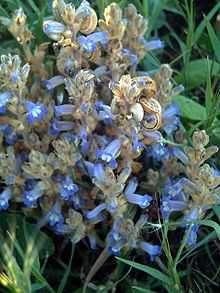Orobanche ramosa
| Orobanche ramosa | |
|---|---|
 | |
| Scientific classification | |
| Kingdom: | Plantae |
| (unranked): | Angiosperms |
| (unranked): | Eudicots |
| (unranked): | Asterids |
| Order: | Lamiales |
| Family: | Orobanchaceae |
| Genus: | Orobanche |
| Species: | P. ramosa |
| Binomial name | |
| Phelipanche ramosa L. | |
Phelipanche ramosa is a species of broomrape known by the common names hemp broomrape and branching broomrape. It is native to Eurasia and North Africa, but it is known in many other places as an introduced species and sometimes a noxious weed. [1]
It is a pest in agricultural fields, infesting crops including tobacco,[2] potato,[3] and tomato.[4]
The plant produces many slender, erect stems from a thick root. The yellowish stems grow 10 to 60 centimeters tall and are coated in glandular hairs. The broomrape is parasitic on other plants, draining nutrients from their roots, and it lacks leaves and chlorophyll. The inflorescence bears several flowers, each in a yellowish calyx of sepals and with a tubular white and blue to purple corolla.
The problems that the invasive, or parasitic weed, Orobanche ramosa, has on agriculture are important. The growth and reproduction of this weed has detrimental effects on our food supply. We have found evidence to help us control[5] this weed. Orobanche and Phelipanche species (the broomrapes) are root parasitic plants, some of which cause heavy yield losses on important crops. The development of herbicides based on natural metabolites from microbial and plant origin, targeting early stages on parasitic plant development, might contribute to the reduction of broomrape seed bank in agricultural soils. Therefore, the effect of metabolites belonging to different classes of natural compounds on broomrape seed germination and radicle development was assayed in vitro. Among the metabolites tested, epi-sphaeropsidone, cyclopaldic acid, and those belonging to the sesquiterpene class induced broomrape germination in a species-specific manner. epi-Epoformin, sphaeropsidin A, and cytochalasans inhibited germination of GR24-treated broomrape seeds.
References
- ↑ Joel, D. M. (2009). The new nomenclature of Orobanche and Phelipanche. Weed Research, 49, 6–7. doi:10.1111/j.1365-3180.2009.00748.x.
- ↑ Karkanis, A., et al. (2007). Tobacco (Nicotiana tabaccum) infection by branched broomrape (Phelipanche ramosa) as influenced by irrigation system and fertilization, under East Mediterranean conditions. Journal of Agronomy 6:3 397-402.
- ↑ Haidar, M. A. et al. (2005). Selective control of Orobanche ramosa in potato with rimsulfuron and sub-lethal doses of glyphosate. Crop Protection 24:8 743-47.
- ↑ Mauromicale, G. et al. (2008). Effect of branched broomrape (Orobanche ramosa) infection on the growth and photosynthesis of tomato. Weed Science 56:4 574-81.
- ↑ Ayebeke, Mehmet (July 2014). "Aspergillus alliaceus, a new potential biological control of the root parasitic weed Orobanche". Journal of Basic Microbiology 54 (Suppl. 1): S93-S101. doi:10.1002/jobm.201300080. PMID 23686407.
Further reading
- Cimmino, Alessio et al. (Oct 29, 2014). "Effect of Fungal and Plant Metabolites on Broomrapes (Orobanche and Phelipanche spp.) Seed Germination and Radicle Growth". Journal of Agricultural and Food Chemistry 62 (43): 10485–10492. doi:10.1021/jf504609w. PMID 25272312. Retrieved 29 April 2015.